|
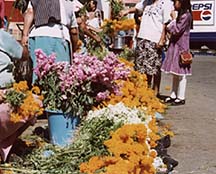 The Day of the Dead, Dia de los Muertos, is a festival celebrating the reunion of dead relatives with their families, November 1st and 2nd.
The Day of the Dead, Dia de los Muertos, is a festival celebrating the reunion of dead relatives with their families, November 1st and 2nd.
Every year, on November 1st (All Saints Day) and 2nd (All Souls Day), something unique takes place in many areas of Mexico: Day of the Dead festivities.
In Spanish, All Saints Day and All Souls Day are known as El Dia de Todos los Santos and El Dia de los Muertos, respectively. While it's strange for most of us to accept the fact that "death" and "festivities" can go hand-in-hand, for most Mexicans, the two are intricately entwined. This all stems from the ancient indigenous peoples of Mexico (Purepecha, Nahua, Totonac and Otomi) who believed that the souls of the dead return each year to visit with their living relatives - to eat, drink and be merry. Just like they did when they were living.
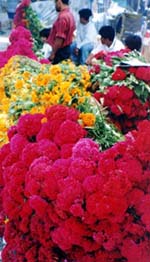 Tempered somewhat by the arrival of the Spaniards in the 15th century, current practice calls for the deceased children (little angels) to be remembered on the previous day (November 1st, All Saints Day) with toys and colorful balloons adorning their graves. And the next day, All Souls Day, adults who have died
are honored with displays of the departed's favorite food and drinks, as well as ornamental and personal belongings. Flowers, particularly the zempasuchil (an Indian word for a special type of marigold) and candles, which are placed on the graves, are supposed to guide the spirits home to their loved ones.
Tempered somewhat by the arrival of the Spaniards in the 15th century, current practice calls for the deceased children (little angels) to be remembered on the previous day (November 1st, All Saints Day) with toys and colorful balloons adorning their graves. And the next day, All Souls Day, adults who have died
are honored with displays of the departed's favorite food and drinks, as well as ornamental and personal belongings. Flowers, particularly the zempasuchil (an Indian word for a special type of marigold) and candles, which are placed on the graves, are supposed to guide the spirits home to their loved ones.
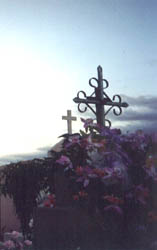 Other symbols include the elaborately-decorated pan de muerto (a rich coffee cake decorated with meringues made to look like bones), skull-shaped candies and sweets, marizpan death figures and papier mache skeletons and skulls. (the Nahua speaking peoples of pre-columbian Mexico saw the skull as a symbol of life - not death.) Today, these macabre symbols and other similar items fill the shops and candy stalls by mid October. During this time, homes are often decorated in the same manner as the graves.
Other symbols include the elaborately-decorated pan de muerto (a rich coffee cake decorated with meringues made to look like bones), skull-shaped candies and sweets, marizpan death figures and papier mache skeletons and skulls. (the Nahua speaking peoples of pre-columbian Mexico saw the skull as a symbol of life - not death.) Today, these macabre symbols and other similar items fill the shops and candy stalls by mid October. During this time, homes are often decorated in the same manner as the graves.
This may all seem morbid and somewhat ghoulish to those who are not part of that culture. But, for Mexicans who believe in the life/death/rebirth continuum, it's all very natural. this is not to say that they treat death lightly. They don't. It's just that they recognize it, mock it, even defy it. Death is part of life and, as such, it's representative of the Mexican spirit and tradition which says: "Don't take anything lying down - even death!"
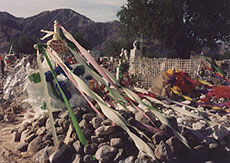 First the graves and altars are prepared by the entire family, whose members bring the departed's favorite food and drink. Candles are lit, the ancient incense copal is burned, prayers and chants for the dead are intoned and then drinks and food are consumed in a party/picnic-like atmosphere. At 6:00 pm, the bells begin to ring (every 30 seconds), summoning the dead. They ring throughout the night. At sunrise, the ringing stops and those relatives who have kept the night-long vigil, go home.
First the graves and altars are prepared by the entire family, whose members bring the departed's favorite food and drink. Candles are lit, the ancient incense copal is burned, prayers and chants for the dead are intoned and then drinks and food are consumed in a party/picnic-like atmosphere. At 6:00 pm, the bells begin to ring (every 30 seconds), summoning the dead. They ring throughout the night. At sunrise, the ringing stops and those relatives who have kept the night-long vigil, go home.
The most vivid and moving Day of the Dead celebrations take place on ths island of Janitzio in Lago de Patzcuaro. Here, at the crack of dawn (on November 1st) the Purepechan Indians get the festivities going with a ceremonial duck hunt. At midnight, the cooked duck and other zesty edibles are brought to the cemetery in the flickering light of thousands of candles. Those visitors who come are in for an awesome spectacle as the women pray and the men chant throughout the chilly night. Other candle-lit ceremonies take place in the nearby towns of Tzintzuntzan (the ancient capital of the Purepechan people), Jarauaro and Erongaricuaro. If you're thinking of witnessing this annual spectacle next year, it's best to make reservations right now since available hotels do fill up quickly.
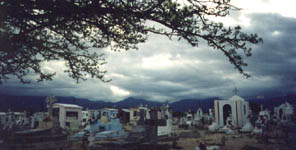
Editor's Note - Most of the nation celebrates El Dia de los Muertos, but here's a list of Mexican cities & villages which are well-known for their observance of the celebrations; Oaxaca, Patzcuaro (Michaocan), Huejutla (State of Hidalgo), Chiapa de Corzo (Chiapas), Jesus Maria (Nayarit), Mixquic (Federal District) and even Tecate (Baja California). • Story compiled and written by Marvin H. Perton
|